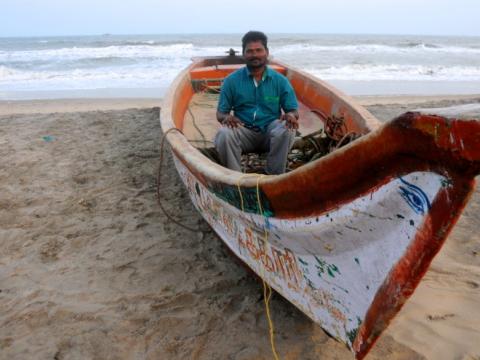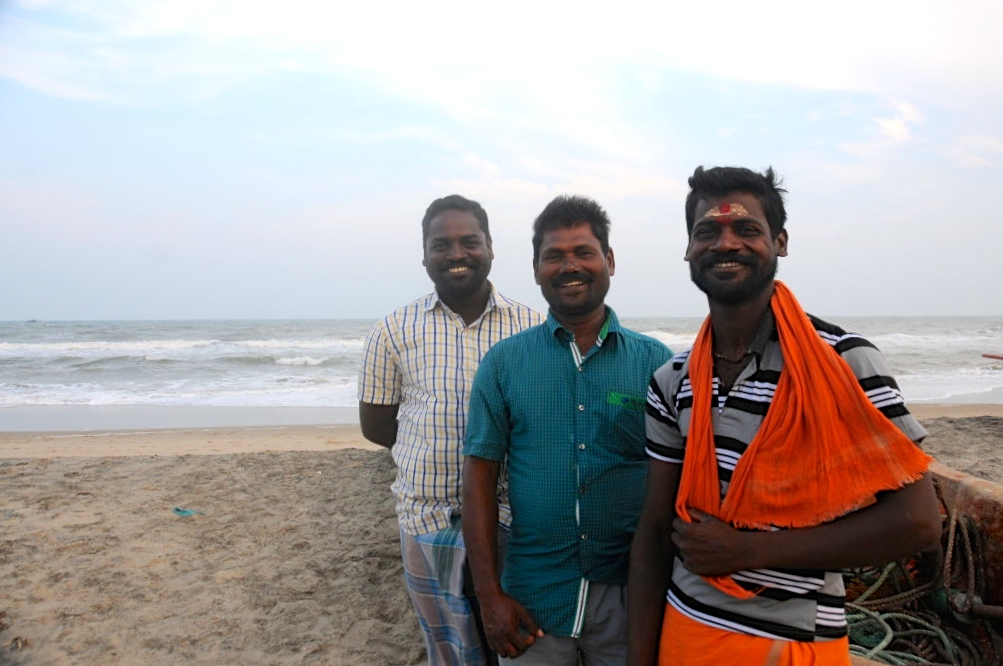How technology has improved the lives of fishing families

“This is her, the boat that you gave us. This is what fed my family for the past ten years,” says Thennavan, as he gently touches the old boat, visibly worn out after 10 years of sailing on the Bay of Bengal every day. “The other boats have gone into the sea,” he adds, a sense of pride in his tone.
Ten years ago, Thennavan’s livelihood from fishing depended only on one small Kattumaram [4 to 5 logs tied together] that he owned. The income he made from it was enough for him to support only his wife and two children.
However, on December 24, 2004, like thousands of other fishermen along the south eastern coast of India, he too lost his livelihood in a matter of a few hours.
The devastating tsunami waves wiped out entire villages, killed thousands of people and left even more, suddenly staring at an uncertain future.
“For the first few weeks, the government and organisations gave us food, shelter and took care of us. But then after that, I didn’t know what to do for income. I had lost the one Kattumaram that I had,” said Thennavan.
World Vision India, as part of its emergency response, provided a fishing boat, 5 different types of fishing nets, GPS equipment, and an icebox to store and transport their catch. Each fishing 'package', worth around Rs.200,000 (approx $3000 USD), was given to a group of five fishermen who would collectively go fishing and share the catch and the profits.
However, after a few months, the other four fishermen in Thennavan’s group wanted to go on their own and did not want to co-own the boat. After having worked out their financial settlements the four fishermen went on their own and Thennavan became the sole owner of the fishing boat.
Thennavan didn’t know how to handle this sudden change. This boat was bigger than the Kattumaram that he once owned. This boat required more than one person to operate it. But determined to continue, he decided to hire people to help him and went into the sea.
“At first it was difficult. I had to pay wages and I had to spend on the boat’s maintenance. So it wasn’t profitable at all, but I did not give up,” says Thennavan.
Gradually, Thennvavan did start rising above the waves. A few years after, he was able to save enough to buy another boat. Then, a few years later he bought one more and it went on that way and today Thennavan owns five boats, has two other chief boatmen and 15 fishermen who work under him.
“Today my life is much better than it used to be even before the tsunami,” he says. “And it’s only because of her,” he adds, as he gently taps the boat that World Vision gave him ten years back.
“But what turned the whole tide around for fishermen like me was this GPS device that World Vision introduced us to,” he continues, “The boats and nets helped us get back to our livelihood of fishing. But it was this device that helped us grow much beyond pre-tsunami days,” says Thennavan.
Previously fishermen, when venturing into the sea would keep, elevations, huge towers, trees, tall buildings on the shore or small islands in the sea as their reference points to mark the places where they are able to get the maximum catch during that season. However, it requires many years of experience and a lot of luck to be able to return to the exact spot in the following days.
And it is almost impossible to share coordinates of that spot with the other fishermen. This meant that fishermen would not get a great catch every single time, a lot of fuel and time was wasted every single time trying to spot the location, and a lot more fuel and time was wasted trying to return precisely to their village on the shore, as they would usually drift away trying to find the hot-spots for a good catch. And all of these challenges were doubly difficult when we are in the sea after sunset.
“The GPS device that World Vision introduced to us solved all of this in an instant,” says Thennavan, excited as he explains how the device works. “Now, all we have to do is mark the GPS co-ordinates on the device as we go, and we or even any other fishermen would be able to return to the exact same spot again,” he adds.
This not only helped the fishermen save a lot of money and time, but also increased their catch and profits many times over, because they were able to fish in the same spot multiple times.
“Despite all of this, the fishing business is getting tougher and riskier,” adds Thennavan. “I send both my sons to very good schools. I want them to study well, get a good salaried job and not depend on fishing to lead their lives,” he says.
World Vision India ,as part of the emergency tsunami response, provided more than 1700 fishing boats, along with different types of nets and lifejackets, iceboxes, storage halls and more than 200 GPS devices, with the objective of restoring and improving the previous living conditions of fishermen affected by the tsunami.
